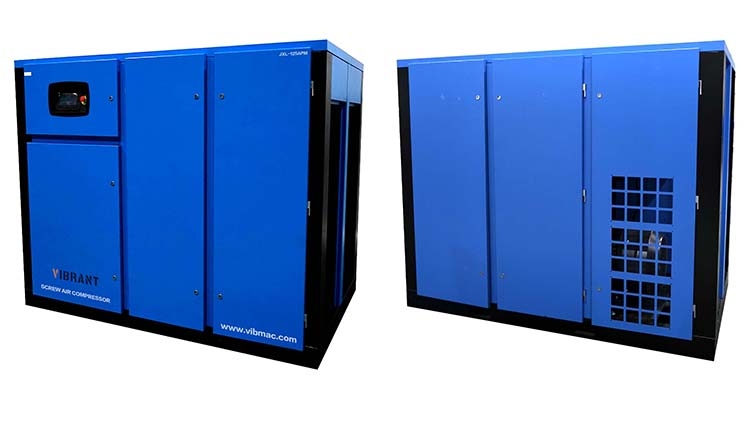
Analysis on the Causes of Motor Shaft Fracture of Air Compressor in a Power Plant
2024-03-15
1. Site Inspection and Macro-analysis
In 2012, an accident occurred when the motor shaft of an air compressor unit at a power generation company broke. On-site inspection revealed that the motor shaft fracture was located in the bearing bushing on the drive side, approximately 200 mm from the connecting gear. The shaft was known to have collapsed during operation and caused wear on the shaft exterior, which was sprayed on the periphery of the power plant. Inspection revealed that the entire circle of the shaft surface near the fracture had been sprayed, with a thickness of about 1mm. The motor shaft fracture had obvious radial lines, with multiple large metallurgical defects on the section, and the source point of the crack was torn off by the metallurgical defects.
The current record of the air compressor motor was accessed on site, and it was found that the current of the motor fluctuated between 14 and 32A every 1 h or so before the shaft fracture because the load of the air compressor was being continuously adjusted. 12 h before the incident, the air compressor has been running with load, the current remained at about 30A, and finally when the incident occurred, the current rose to 32A, and the motor shaft broke.
2. Fracture Test Analysis
Use X-Met3000TX handheld spectrometer to test the motor shaft, and find that the motor shaft matrix and coating layer contain two elements of Fe and Mn, without other alloying elements, and the material of both is carbon steel.
2.1 Morphological Inspection of Section Microstructure
Under the microscope, we observed the fracture morphology and found that there were relatively many metallurgical defects inside the fracture, and the cracks along the metallurgical defects cracked and expanded.
Polish the specimen, use 4% nitric acid alcohol solution for etching, the specimen section shows four different organization and morphology ( shown in Figure 1~Figure 4 ). The specimen section is different, the tissue morphology of the region is different, of which Figure 1 is the coating tissue morphology.

As can be seen from Figure 1, at the sprayed layer, the tissue morphology shows a wavy shape, and it is impossible to determine the specific organization, which is obviously not the normal tissue morphology of carbon steel.
As can be seen from Figure 2, there are two types of morphology at the location of the near-sprayed layer, one for the needle-like martensite organization, and one for the first eutectic ferrite and pearlite . Because the spraying temperature exceeds the Ac1 phase transition point of the axial material, there is no tempering after air cooling, so there is an acicular martensite organization.
As can be seen in Figure 3, the organization of the near-matrix position is pre-eutectoid ferrite and pearlite.
From Figure 4, it can be seen that the tissue morphology at the position of the matrix is pearlitic and weinzite, which is a typical superheated tissue morphology.
From the figure, it can also be seen that the crack originates from the internal metallurgical defects, expanding from inside to outside, with a large crack opening.
2.2 Hardness Test
Use Richter hardness tester, and test on the motor shaft base body and spraying layer, the test results show that the hardness value of the matrix is about 156HB, and the hardness value of the spraying layer is about 356HB, which has a great difference.
3. Analysis of Causes
(1) From the fracture morphology, microscopic and macroscopic examination, it can be seen that there are a large number of metallurgical defects and macroscopic cracks inside the matrix of the motor shaft, and the cracks originate from the metallurgical defects inside the matrix, expanding from the inside to the outside.
(2)The use state of the common shaft body is tempering organization, namely quenching and high-temperature tempering organization. While the metallographic organization of the broken shaft matrix is coarse pearlite organization and Weil’s body organization, belonging to the normalized organization form. When heating by normalization, the superheating time is relatively long, resulting in coarse organization. The division of the matrix by the Wei’s organization and coarse organization form makes the strength and impact toughness of the motor shaft lower, and the brittleness rises.
(3) The results of the hardness test can show that the difference between the hardness of the sprayed layer and the substrate is about 200HB, which will make the surface stress at the bonding surface large, and the heating temperature will be too high when the motor shaft body is sprayed and repaired, which will lead to the emergence of hardened martensitic organization in the local area of the shaft body, and these factors promote the cracking and expansion of the defects under the action of the external loads.
(4) During normal operation of the air compressor, if the loading and unloading processes are carried out frequently, the impact force will form continuously on the drive side of the motor shaft. The defects inside the matrix expand under the impact force, eventually causing brittle fracture of the motor shaft.
4. Conclusion
Our company analyzed the cause of fracture of the motor shaft of the air compressor of a power generation company, and the results showed that the manufacturing quality of the motor shaft body was seriously unqualified, and there were macroscopic cracks and a large number of metallurgical defects inside the matrix. During the normal operation of the air compressor, the impact force formed by loading and unloading will cause the internal cracks to expand and then fracture.
Manufacturers should use qualified forgings in the manufacturing process of motor shafts, strictly follow the heat treatment process, and check the quality of the products. The power plant should ask for relevant drawings and quality documents when the equipment is purchased. Check here.








